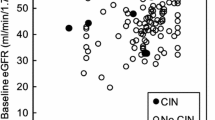Abstract
Purpose
To compare the incidence of contrast-induced nephropathy (CIN) for intravenous vs. intra-arterial administration of iodixanol, compared to non-administration.
Methods
We retrospectively identified 650 patients who had intravenous iodixanol-enhanced CT, 695 with intra-arterial iodixanol cardiac catheterization, 651 with unenhanced CT, and those who also had baseline and follow-up serum creatinine within 5 days of the exam. From the medical records, we recorded the gender, age, baseline and follow-up serum creatinine/eGFR; underlying renal injury risk factors; indication for imaging; contrast material administration volume, concentration, and route of administration; and use of pre-imaging prophylactic measures for CIN. Univariate and multivariate models were used to determine predictors of CIN.
Results
Baseline eGFR was lower for patients undergoing unenhanced CT than intravenous or intra-arterial patients (68 vs. 74.6 and 72.2, respectively, p < 0.01) and not different between intravenous and intra-arterial patients (p = 0.735). Simple logistic regression did not show a difference in the rate of CIN in patients who received intravenous vs. intra-arterial iodixanol (28 of 650, 4%, vs. 28 of 695, 4%, respectively, p = 0.798), nor a higher rate of CIN than seen with unenhanced CT (45 of 651, 7%, p = 0.99 and p = 0.98 by one-sided t test). Multivariate regression modeling showed that only elevated baseline creatinine or decreased eGFR and low hematocrit/hemoglobin were associated with CIN incidence (odds ratio 1.28 and 2.5; p < 0.023 and <0.006, respectively).
Conclusions
Elevation in serum creatinine due to intravenous and intra-arterial iodixanol administration is infrequent and is not more common than after unenhanced CT scans.

Similar content being viewed by others
References
Elicker BM, Cypel YS, Weinreb JC (2006) IV contrast administration for CT: a survey of practices for the screening and prevention of contrast nephropathy. AJR Am J Roentgenol 186(6):1651–1658. doi:10.2214/AJR.05.0407
Chou SH, Wang ZJ, Kuo J, et al. (2011) Persistent renal enhancement after intra-arterial versus intravenous iodixanol administration. Eur J Radiol 80(2):378–386. doi:10.1016/j.ejrad.2011.02.044
Stacul F, van der Molen AJ, Reimer P, et al. (2011) Contrast induced nephropathy: updated ESUR Contrast Media Safety Committee guidelines. Eur Radiol 21(12):2527–2541. doi:10.1007/s00330-011-2225-0
Katzberg RW, Newhouse JH (2010) Intravenous contrast medium-induced nephrotoxicity: is the medical risk really as great as we have come to believe? Radiology 256(1):21–28. doi:10.1148/radiol.10092000
Davenport MS, Khalatbari S, Dillman JR, et al. (2013) Contrast material-induced nephrotoxicity and intravenous low-osmolality iodinated contrast material. Radiology 267(1):94–105. doi:10.1148/radiol.12121394
McDonald JS, McDonald RJ, Comin J, et al. (2013) Frequency of acute kidney injury following intravenous contrast medium administration: a systematic review and meta-analysis. Radiology 267(1):119–128. doi:10.1148/radiol.12121460
Newhouse JH, Kho D, Rao QA, et al. (2008) Frequency of serum creatinine changes in the absence of iodinated contrast material: implications for studies of contrast nephrotoxicity. AJR Am J Roentgenol 191(2):376–382. doi:10.2214/AJR.07.3280
Karlsberg RP, Dohad SY, Sheng R, et al. (2011) Contrast medium-induced acute kidney injury: comparison of intravenous and intraarterial administration of iodinated contrast medium. J Vasc Interv Radiol 22(8):1159–1165. doi:10.1016/j.jvir.2011.03.020
Kooiman J, Le Haen PA, Gezgin G, et al. (2013) Contrast-induced acute kidney injury and clinical outcomes after intra-arterial and intravenous contrast administration: risk comparison adjusted for patient characteristics by design. Am Heart J 165(5):793–799, 799.e1. doi:10.1016/j.ahj.2013.02.013
Aspelin P, Aubry P, Fransson SG, et al. (2003) Nephrotoxic effects in high-risk patients undergoing angiography. New Engl J Med 348(6):491–499. doi:10.1056/NEJMoa021833
Biondi-Zoccai G, Lotrionte M, Thomsen HS, et al. (2014) Nephropathy after administration of iso-osmolar and low-osmolar contrast media: evidence from a network meta-analysis. Int J Cardiol 172(2):375–380. doi:10.1016/j.ijcard.2014.01.075
Li WHLD, Han F, Xu TD, et al. (2013) Impact of anemia on contrast-induced nephropathy (CIN) in patients undergoing percutaneous coronary interventions. Int Urol Nephrol 45(4):1065–1070
Nikolsky E, Mehran R, Lasic Z, et al. (2005) Low hematocrit predicts contrast-induced nephropathy after percutaneous coronary interventions. Kidney Int 67:706–713
Mehran R, Aymong ED, Nikolsky E, et al. (2004) A simple risk score for prediction of contrast-induced nephropathy after percutaneous coronary intervention: development and initial validation. J Am Coll Cardiol 44(7):1393–1399
McClellan W, Aronoff SL, Bolton WK, et al. (2004) The prevalence of anemia in patients with chronic kidney disease. Curr Med Res Opin 20(9):1501–1510. doi:10.1185/030079904X2763
Jie KE, Verhaar MC, Cramer MJ, et al. (2006) Erythropoietin and the cardiorenal syndrome: cellular mechanisms on the cardiorenal connectors. Am J Physiol Renal Physiol 291(5):932–944
Chertow GM, Burdick E, Honour M, et al. (2005) Acute kidney injury, mortality, length of stay, and costs in hospitalized patients. J Am Soc Nephrol 16(11):3365–3370. doi:10.1681/ASN.2004090740
Nash K, Hafeez A, Hou S (2002) Hospital-acquired renal insufficiency. Am J Kidney Dis 39(5):930–936. doi:10.1053/ajkd.2002.32766
Bruce RJ, Djamali A, Shinki K, et al. (2009) Background fluctuation of kidney function versus contrast-induced nephrotoxicity. AJR Am J Roentgenol 192(3):711–718. doi:10.2214/AJR.08.1413
Moore RD, Steinberg EP, Powe NR, et al. (1992) Nephrotoxicity of high-osmolality versus low-osmolality contrast media: randomized clinical trial. Radiology 182(3):649–655. doi:10.1148/radiology.182.3.1535876
McDonald RJ, McDonald JS, Bida JP, et al. (2013) Intravenous contrast material-induced nephropathy: causal or coincident phenomenon? Radiology 267(1):106–118. doi:10.1148/radiol.12121823
Newhouse JH, RoyChoudhury A (2013) Quantitating contrast medium-induced nephropathy: controlling the controls. Radiology 267(1):4–8. doi:10.1148/radiol.13122876
Acknowledgements
This study was supported by grants from General Electric Healthcare, NIH Grant Numbers 1R21EB013816 and 1R01EB015476, and the National Center for Advancing Translational Sciences, National Institutes of Health, through UCSF-CTSI Grant Number UL1 TR000004. Its contents are solely the responsibility of the authors and do not necessarily represent the official views of General Electric Healthcare or the NIH.
Author information
Authors and Affiliations
Corresponding author
Rights and permissions
About this article
Cite this article
Tong, G.E., Kumar, S., Chong, K.C. et al. Risk of contrast-induced nephropathy for patients receiving intravenous vs. intra-arterial iodixanol administration. Abdom Radiol 41, 91–99 (2016). https://doi.org/10.1007/s00261-015-0611-9
Published:
Issue Date:
DOI: https://doi.org/10.1007/s00261-015-0611-9




